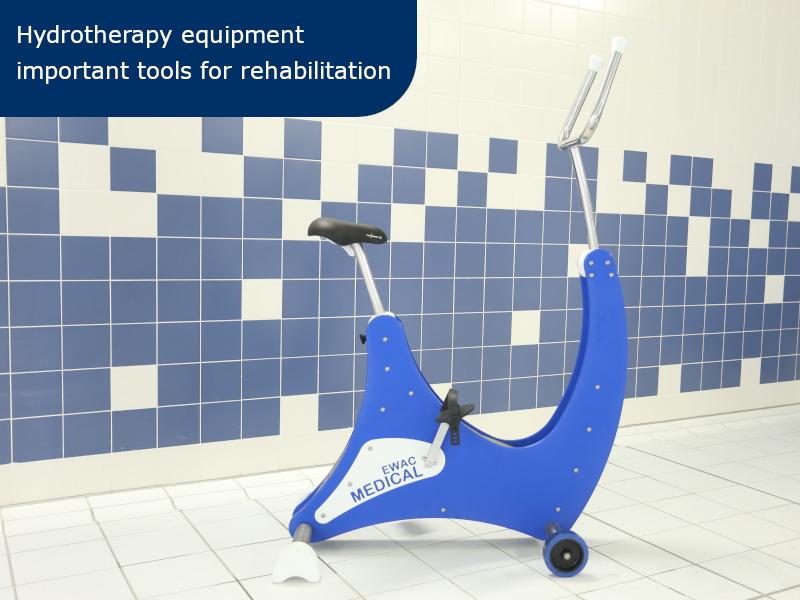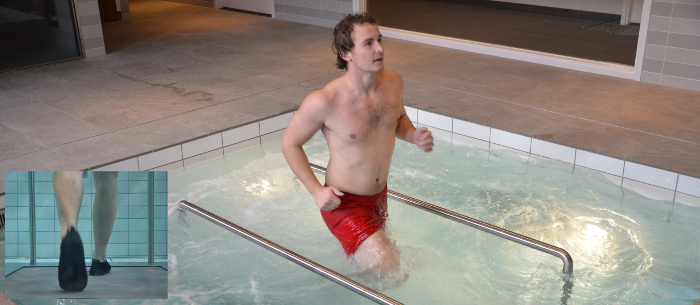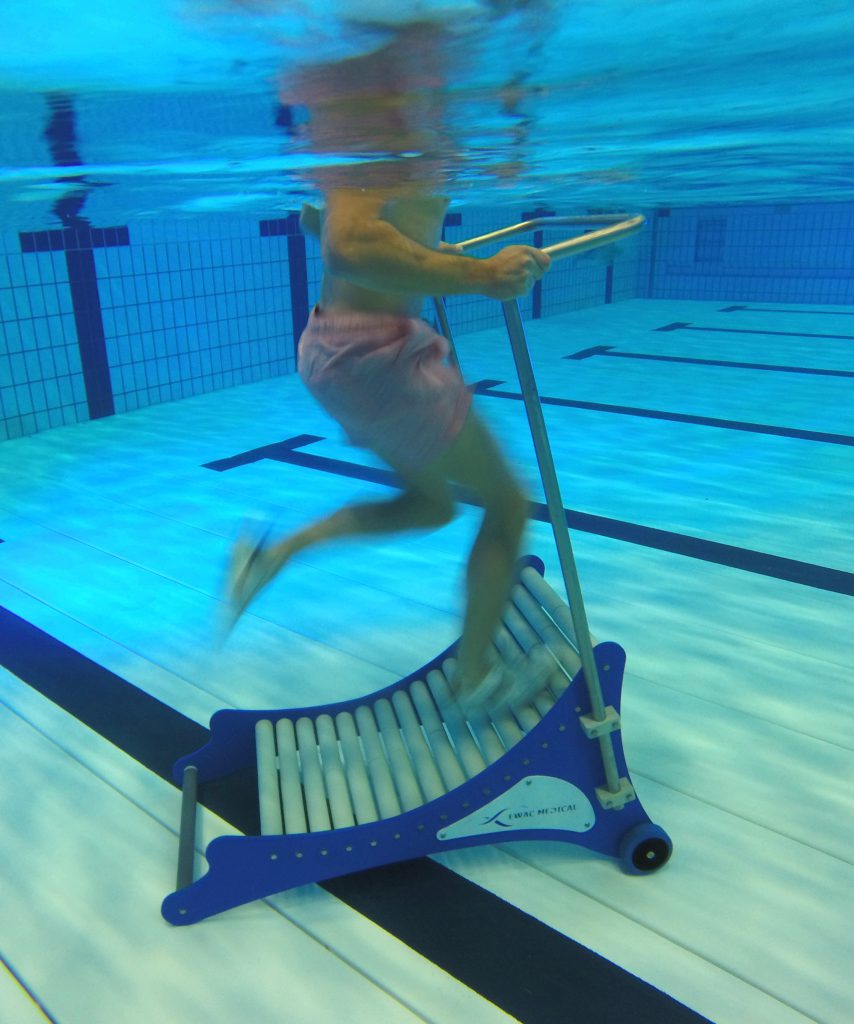Physical medicine and rehabilitation aims to enhance and restore functional ability, independence and quality of life to those with physical impairments or disabilities, irrespective of age, affecting the brain, spinal cord, nerves, bones, joints, ligaments, muscles, and tendons (source: AAPMR).
It is a multi-disciplinary approach in which also aquatic rehabilitation, mostly by a physiotherapist, is a valuable intervention. A pool is a safe environment in which activities with low mechanical impact but significant physiological load can be conducted. Exercise dosage is easily adjustable, and equipment aids clinical decision-making about goals, intensity, and approach.
Hydrotherapy equipment fulfils an important role in water-based rehabilitation.
Create a safe and low impact exercise environment
Hydrotherapy equipment assists physiotherapists and rehabilitation specialists in creating a safe water environment in which to exercise. It enables therapists to take advantage of the special features that water has to offer:
- Warmth, which relaxes muscles and improves joint mobility
- All exercises are slowed down due to movement resistance
- Increase in central blood volume, which improves heart efficiency
- An unbalanced impact that strengthens the core muscles
- Strong water currents can help with underwater massage, but they can also help with balance and strength training
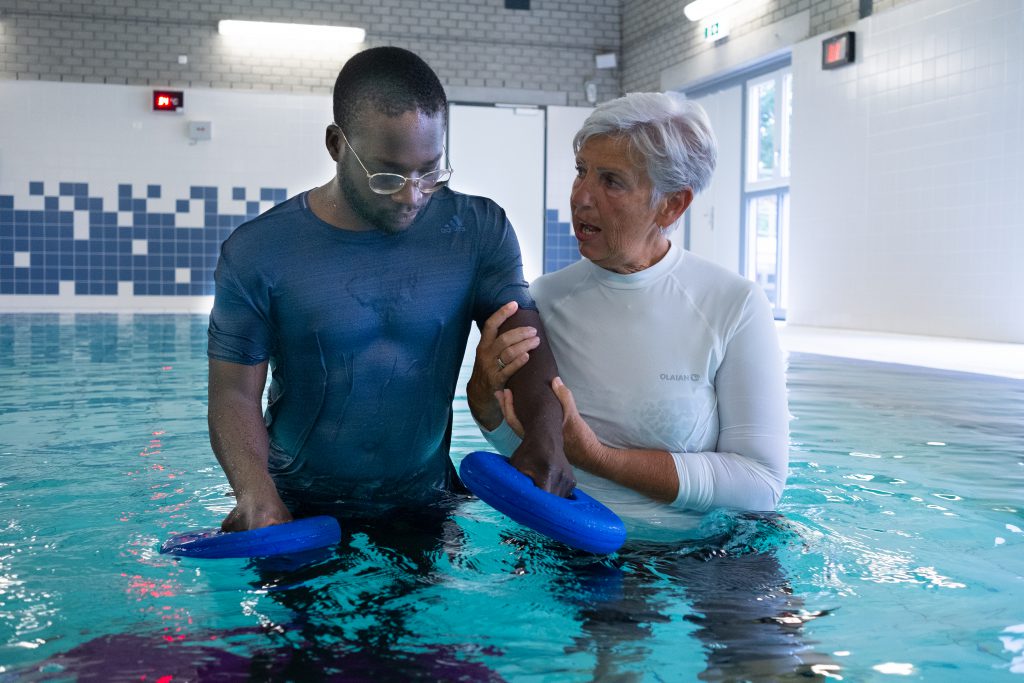
What is aquatic therapy and what is hydrotherapy?
In both cases it is therapy with water (aqua = Latin and hydro = Greek). Let’s start with some history. Water’s beneficial properties have been documented in Roman, Greek, and even Egyptian civilizations for over 4000 years. Egyptian aristocracy bathed in water infused with essential oils and flowers, whereas the Romans had public baths for their citizens. Hippocrates, the Greek physician and father of modern medicine, recommended swimming in spring water to cure illness. Japan and China are two more nations with a long history of hydrotherapy. In Japan, hydrotherapy was concentrated on Japanese hot springs, or “onsen.” This was long before the Romans invented their “Thermae,” or bathing establishments.
The term Hydrotherapy was reduced down to therapy in water (full immersion) in the English Commonwealth and is also used as ‘Hydrotherapie’ in the Netherlands. In Germany, however, water therapy is known as ‘Wassertherapie’, whereas water therapy, such as showers and arm/leg baths, is known as ‘Hydrotherapie’. In the United States, the term Hydrotherapy is used in the same way that it is in Germany, and the name Aquatic Therapy is used for water therapy. However, during the last decade, the word Hydrotherapy has been steadily superseded by the phrase Aquatic Therapy. In 2008, the English “Hydrotherapy Association of Chartered Physiotherapists” rebranded themselves “Aquatic Therapy Association of Chartered Physiotherapists“. Any certified health professional can provide aquatic therapy, such as aquatic physiotherapy or aquatic occupational therapy.
A definition: Aquatic (Physical) Therapy – APT – is a program that combines the mechanical and thermal properties of water during partial or complete immersion with the effects of movement. It elicits the short-term and long-term adaptational mechanisms of a person with a disturbed biological system, employing specialized stimuli to induce biological adaptations and hence therapeutic outcomes. APT primarily targets children and adults with neuromusculoskeletal disorders, as well as supporting systems such as the circulatory, pulmonary, and metabolic systems.
Low gravity environment and water temperature
The greater trouble a person has on land (mainly due to gravity), the more options aquatic therapy provides. In such circumstances, movement intensity may be extremely low, or only passive movements may be possible. Water temperature must be adjusted to the individual’s thermal comfort, therefore the normal temperature in aquatic treatment pools is around 31 °C ±2 °C.
Temperatures should be kept below 30 °C if there is a propensity to increase exercise intensity.
Intensity of the exercises
A client should feel tired after an aquatic therapy session in order to elicit adaptational processes in tissues and systems. Water, according to research, is a great medium for this. This should result in functional benefits on land, increasing motivation and re-sparking engagement with the exercise program. This explains the distinction between aquatic treatment and swimming: Aquatic Therapy is physical exercise in water, aimed at increasing land-based performance. Swimming is physical exercise performed in a pool which could be therapeutic. However, Aquatic Therapy includes more specific methods to gain the desired therapeutic goals.
The International Classification of Function, Disability and Health (ICF) is normally used to streamline goal setting. Examples at the level of function and structure are: muscle strengthening and joint mobilization. Examples of goals at the level of activity are: walking stairs, transferring the center of gravity, reaching and grasping. Quality of Life, self-efficacy and resilience are goals that can be added to the ICF’s goals.
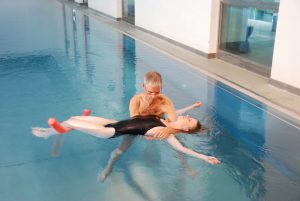
Complementary to regular physiotherapy
Aquatic therapy is primarily based on physiotherapy and is performed by experienced physiotherapists who have completed post-graduate training. This prevents land-based physiotherapy from simply being transposed to a pool without making use of the special benefits that water has to offer, as previously noted. Methods can be passive (for example, joint manipulations in water), but the majority are active. The majority of aquatic therapy pools can be found in rehabilitation centers and hospitals, where clients must relearn lost abilities.
Aquatic Therapy can be viewed as a specialized form of physiotherapy, which involves the use of water to achieve similar improvement goals such as:
- bodily balance
- range of motion of the joints
- trunk stability and flexibility
- movement control
- walking patterns
- reduced pain sensation
Buoyancy in water reduces gravity
Aquatic Therapy provides numerous advantages over other forms of rehabilitation. Because buoyancy compensates gravity (and hence lessens weight-loading on joints), those who struggle to maintain their trunk upright or move limbs are better able to do so. When opposed to a land-based context, trunk muscles in an aquatic environment require only around 25% of their typical tension to stabilize the trunk. This means that there is less co-contraction in the water, allowing for more joint range of motion.
Hydrostatic pressure promotes blood circulation, which is required to provide tissues with hydration, nutrients, and oxygen while also eliminating metabolic waste products. This improves muscular function.
Water’s resistance to movement is based on its viscosity and density. Density of water is substantially (1000x) greater than air.

Would you like to learn more about the basics of hydrotherapy? Request information about the hydrotherapy training we offer.
The difference between passive and active hydrotherapy
In passive hydrotherapy, the individual is passive and immersed in water, receiving treatment by simply being immersed (e.g., floating), from a hydrotherapy appliance such as a massage bath, or from a therapist. A therapist can manipulate joints or use massage techniques to alleviate pain or increase range of motion.
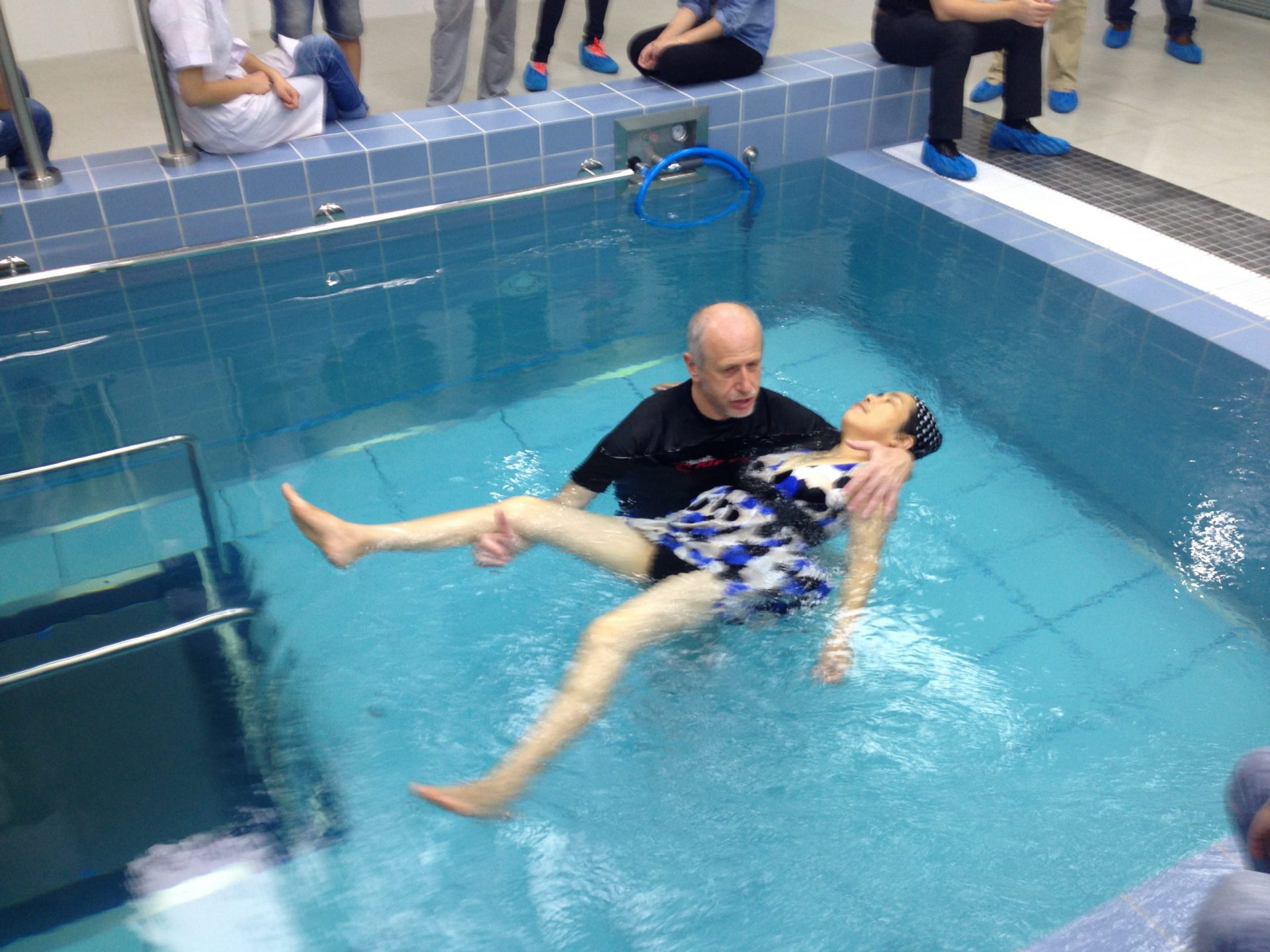
Passive practice of hydrotherapy, therapist with individual in waterClassic hydrotherapy typically involves people sitting in a bath, soaking and resting in warm water. This is referred to as passive stationary exercises and immersion. Several innovative doctors who were not afraid to experiment began to introduce several treatments utilizing immersion around the years 1700 – 1800. Medicinal herbs, underwater massages, and underwater joint manipulation could all be used in these treatments. Others, particularly Sebastian Kneipp, established the concept of hot/cold treatments to improve circulation, which had therapeutic benefits on the body.
In modern hydrotherapy thought, these treatments are still considered passive because the individual receives the treatment rather than taking a physically active role in their rehabilitation. Still, a person might be actively involved by sensing changes in the body, such as during Jacobson’s relaxing method (proprioceptive discrimination training as also in mindful concepts).
Participants in active Aquatic Therapy use their motor output system, which involves using muscles to generate force. This can be done at any force output level, from fine tuning small spinal muscles at 5% of maximum to over 100% in the eccentric phase of a plyometric contraction. The Bad Ragaz Ring Method is an example of an aquatic “strengthening” technique. Hands-on and hands-off strategies are both used. In hands-off strategies, usually water resistance equipment is used.
Strengthening aids coordination in daily activities. As a result, postural coordination training is an important component of active aquatic therapy. This is mostly tied to standing and walking (ask patients in a rehabilitation clinic about their aspirations, and they will always say, “I want to walk again: safe, alone, fast”). Standing and walking can lead to falls; therefore, EWAC Medical have developed the obstacle course to train for fall prevention.
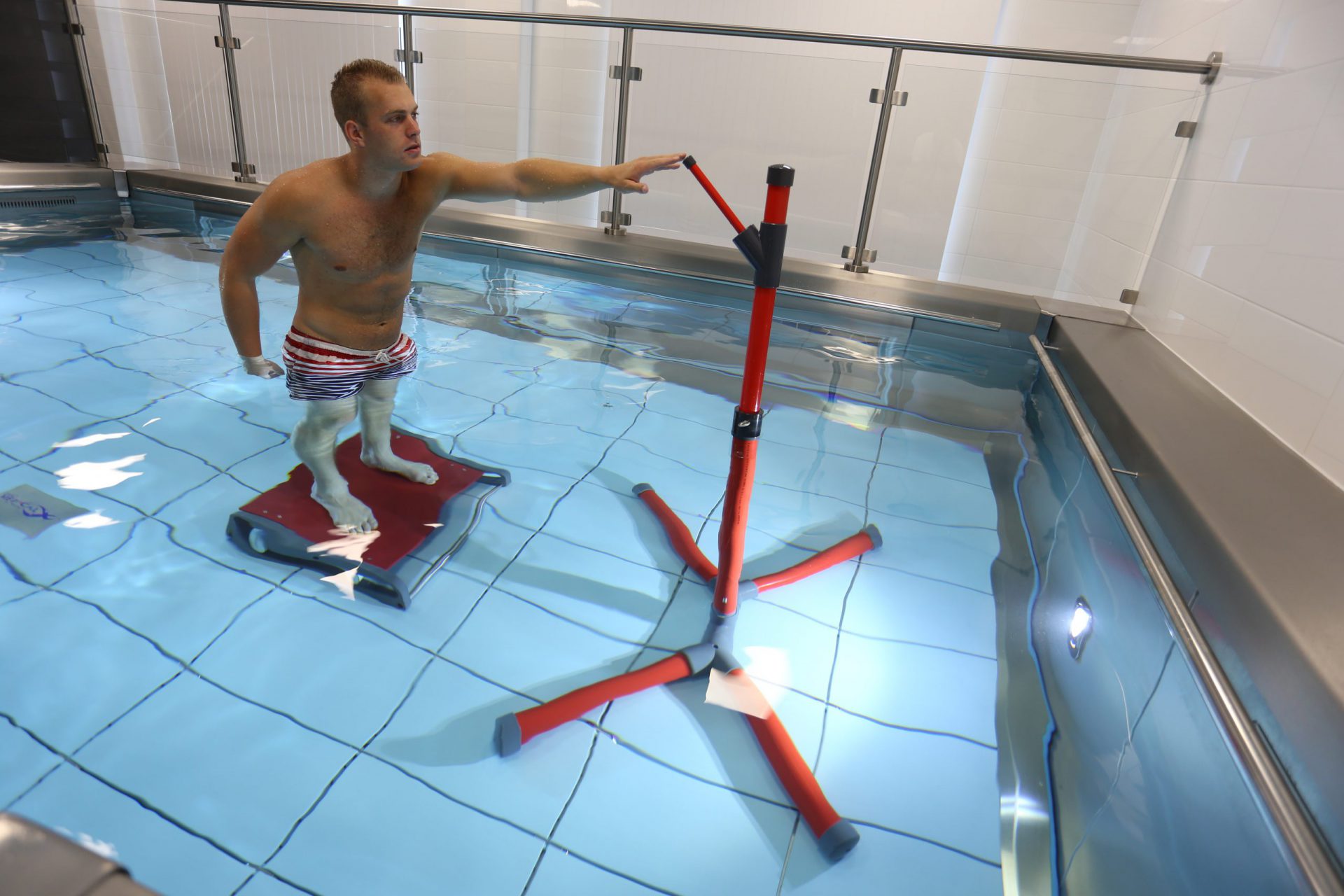
The obstacle course is perfect for practicing unexpected disruptions. When a person reacts too late, stumbling or even falling is a gradual process that can still be reversed. Turbulent water affects posture in a “water-specific” way. Underwater jets can be employed to raise perturbing forces even further.
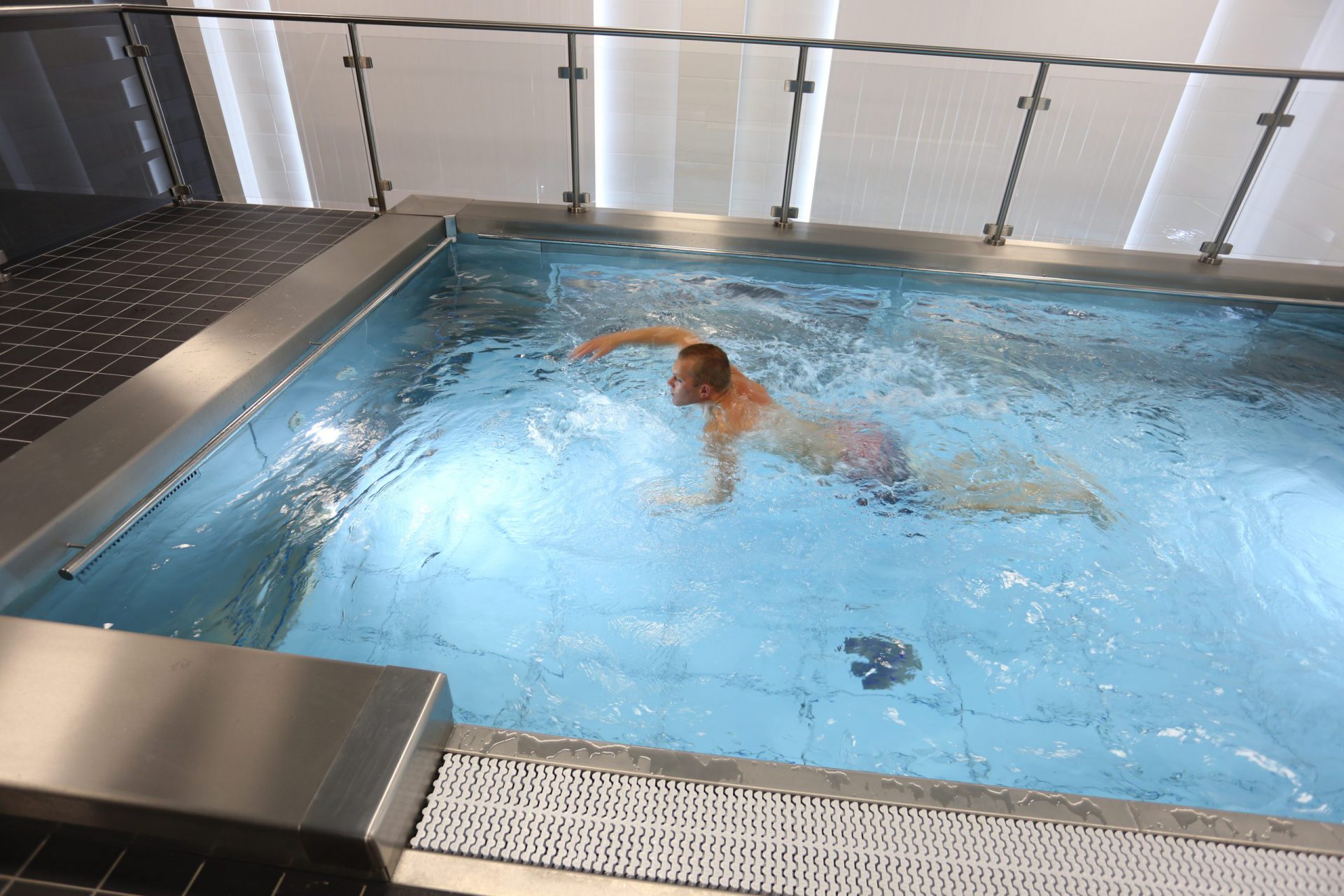
Walking is generally an automated procedure during which we think about other things. To train this automatism, a person needs to repeat a lot: this is to calibrate the central pattern generators for locomotion and to train muscular – and cardiovascular endurance. EWAC Medical provides the underwater treadmill for this purpose.
Active hydrotherapy, individual on an underwater treadmill in a pool
The ability for a person to move freely in a safe environment while interacting with others is critical. This provides opportunities to enrich the environment and train executive functions, primarily through serious gaming-like activities. Playing = learning, but also distracting and relaxing in order to create resilience and self-efficacy.
Get in touch with our team to receive more information or visit our knowledge base
Do you need practical training? Sign up for the hydrotherapy training we offer.
Active hydrotherapy equipment
The right depth, essential in active hydrotherapy
When should you opt for fixed depth versus variable depth? Standard concrete or modular pools have a fixed depth and can accommodate active hydrotherapy. At the same time, no two people are alike. Their height, as well as their diagnosis and capacity to move, vary greatly. For example, a different depth is required for youngsters to have an appropriate exercise setting than for a basketball player. This is why, as one of the most essential forms of hydrotherapy equipment for active hydrotherapy, the movable floor was designed. The movable floor allows the therapist to choose a depth based on the individual’s demands, precisely tailored to the exercises planned.

The therapist can easily modify the depth of a pool with a movable floor to meet the needs of both the therapist and the individual. Furthermore, a movable floor allows the therapist to gradually raise the amount of weight carried by the joints and spine as the individual’s abilities improve. The movable floor can also be raised to deck level for easier transfer. In a nutshell, it is very difficult to create an appropriate atmosphere for active hydrotherapy without this vital piece of hydrotherapy equipment.
Take a look at our movable floor
Stainless steel versus concrete pools
The most crucial piece of active hydrotherapy equipment is most likely a swimming pool. It is also one of the most expensive in terms of initial investment, ongoing maintenance, and energy use. Choosing the correct pool for hydrotherapy application is therefore critical to the success of water-based rehabilitation. What are the distinctions between concrete and modular pools? See our article “Why stainless steel is better than concrete” for more information on the structural differences between concrete and stainless steel pools.
Concrete pool
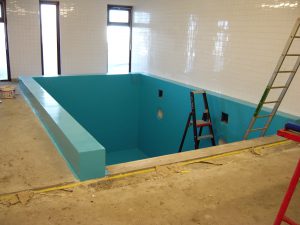
Pools are typically made of concrete and covered with a watertight lining and tiles to keep water in. Modern hydrotherapy pools typically have a movable floor that allows the pool depth to be adjusted. These pools can also be outfitted with viewing windows, giving the therapist a good view of how exercises are performed. However, as a more modern option, a concrete pool can be outfitted with underwater cameras, allowing the therapist to see the entire exercise and store footage for tracking progress.
Many of our clients prefer a concrete pool with a movable floor because concrete is easy to construct in any size or shape, is widely available, and is relatively inexpensive. Another consideration is that many places already have a pool to which they would like to add a movable floor.
Stainless steel Modular pool
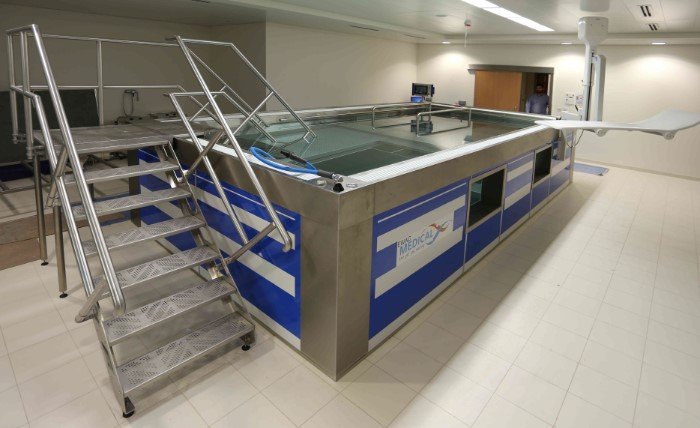
Many rehabilitation clinics prefer modular pools to concrete pools because they are more versatile and customizable. A modular pool is a piece of hydrotherapy equipment that can be fitted in any accessible room to convert it into a hydrotherapy area. The pool’s modular design features multiple panels which can be bolted together on-site. All of the elements arrive at the site prefabricated, and after 10 days of installation, a completely functional stainless steel pool with exceptional hygienic features can be installed. A modular pool, like any other pool, can be outfitted with a moveable floor, observation windows, cameras, and underwater treadmills.
In contrast to concrete hydrotherapy pools, a modular pool can be disassembled and rebuilt elsewhere if necessary.
When there is an existing location but no concrete pool, our clients typically choose a modular pool. Another reason is that modular pools are much quicker to build and assemble on-site. During the construction phase of the pool, the client has a single point of contact, after which the pool is almost maintenance-free, ensuring optimal facility uptime.
Take a look at our modular pool
The unique added value of an Underwater treadmill
The underwater treadmill is the most advanced accessory on the market right now. The underwater treadmill can be installed in the pool bottom or in the movable floor. When the underwater treadmill is integrated into the movable floor, the user can undertake stationary walking exercises under varied gravity conditions, giving the therapist a wide range of therapy options. The underwater treadmill is programmable, allowing the training regimen to be tailored to the individual’s demands. The underwater treadmill is one of the most adaptable pieces of hydrotherapy equipment when combined with an underwater camera system for recording session data.
As previously said, the treadmill allows a person to complete a huge number of repetitions, which falls into the concept of massed practice. Furthermore, gait variety can be learned by randomly adjusting the speed. Nikolai Bernstein, the inventor of contemporary motor learning, claimed, “repetition without repetition.”
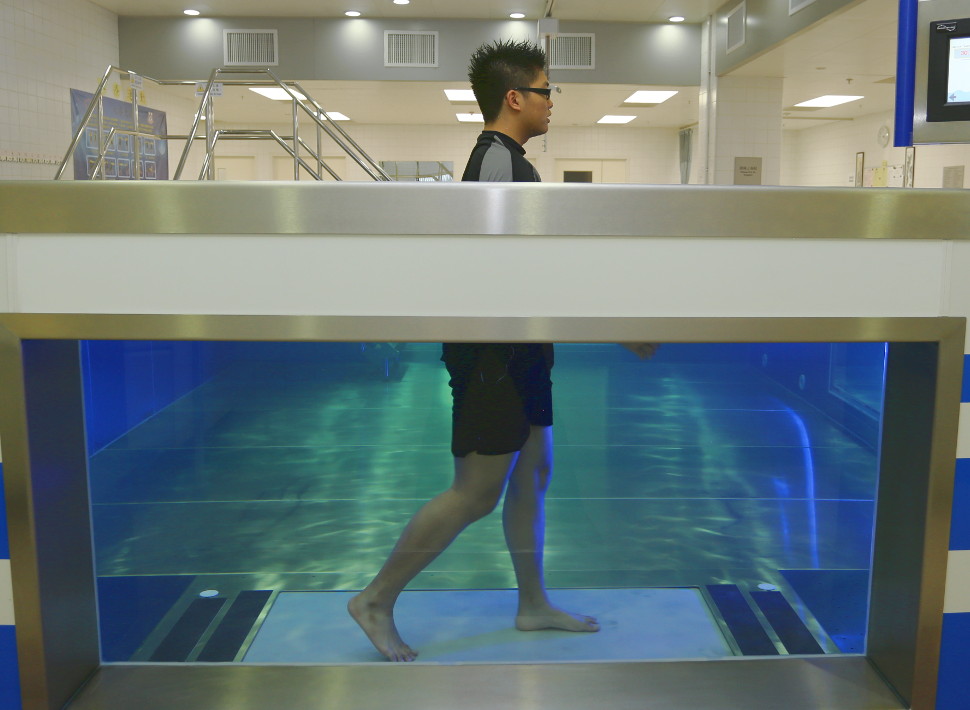 Underwater treadmill in a modular pool, Pok Hoi Hospital, Hong Kong
Underwater treadmill in a modular pool, Pok Hoi Hospital, Hong Kong
Take a look at our underwater treadmill
Self-propelled underwater treadmill
In other cases, purchasing an electrically powered underwater treadmill is simply not an option. In this instance, the Pooltrack® Curve can still be used to do stationary walking activities underwater. The Pooltrack® curve is a piece of hydrotherapy equipment that allows persons to walk on a set of underwater rollers. This improves muscle control and trunk stability.
The EWAC Medical Pooltrack Curve self propelled underwater treadmillTake a look at our Pooltrack Curve
Underwater bicycle, a home trainer in water
The underwater bicycle is another useful piece of hydrotherapy equipment. This underwater bicycle functions similarly to a water-based home trainer, employing the unique qualities of water to generate speed-dependent resistance. The therapist can give a wide range of treatment conditions to train with the underwater bicycle if the water depth can be altered using a moveable floor.
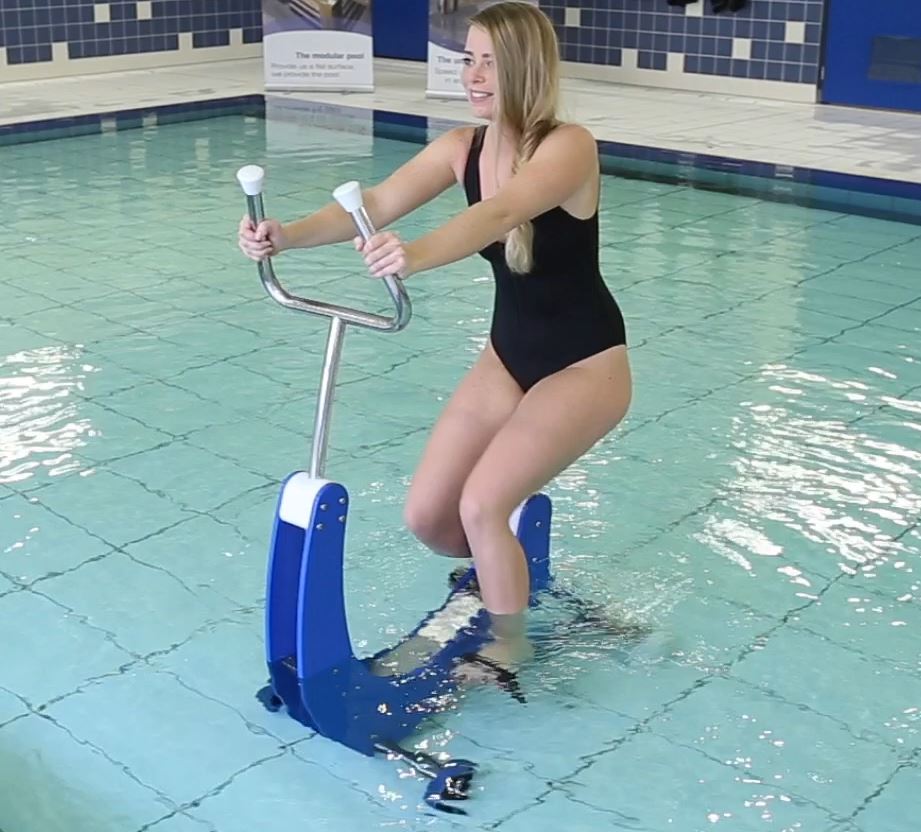
Take a look at our underwater bicycle
Obstacle course, for safe balance control
A very challenging underwater obstacle circuit can be made using an underwater obstacle course, and individuals can be coached in pro-active and reactive balance management abilities. The underwater obstacle course includes a variety of elements such as balance beams, underwater hurdles, a wiggle board, and a reaching pole to simulate many events that may arise in daily life.
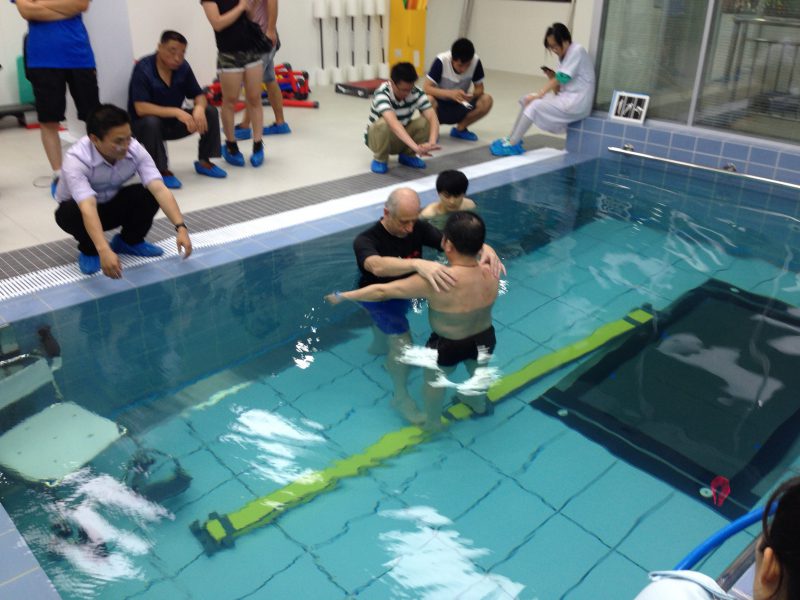
Take a look at our underwater obstacle course
Passive hydrotherapy equipment
The Hubbard tank or butterfly bath. A butterfly-shaped bath for passive stationary exercises
The Hubbard tank or butterfly bath is an example of a bath built for passive aquatic therapy. The butterfly design of this bath allows people to move their limbs freely while also allowing the therapist to easily reach the vital muscles from all sides, for example, to help bend the joints or apply underwater massage.
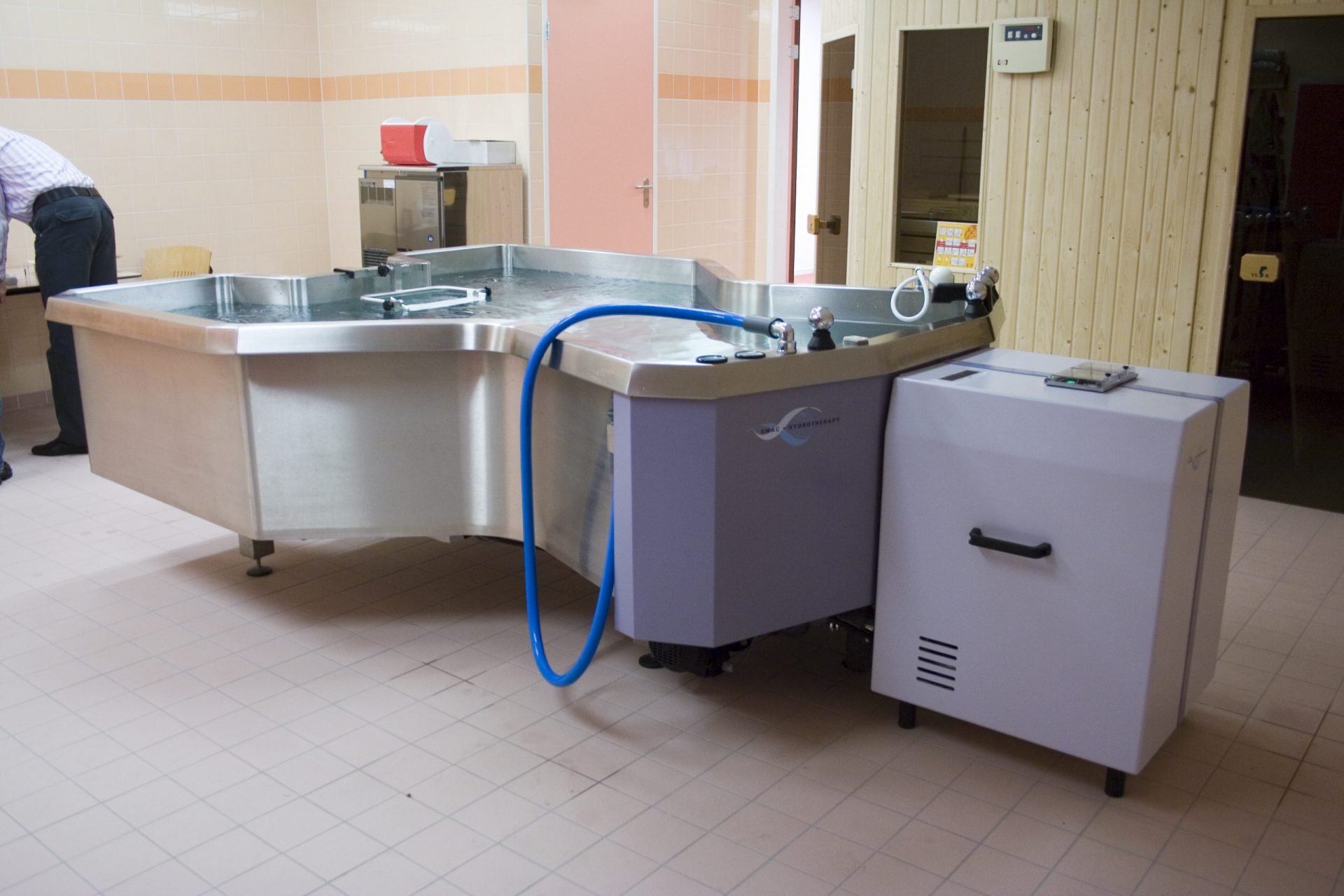
Active hydrotherapy equipment frequently provides a greater range of motion than passive hydrotherapy equipment. Individuals carry out their movements independently, rather than having a therapist do the actions on them. We recommend that our clients choose larger hydrotherapy equipment, such as a movable floor in a concrete pool or a modular pool, for active hydrotherapy.
Take a look at our butterfly bath / Hubbard tank
Smaller baths and pools for passive hydrotherapy
Smaller baths and pools are used in passive hydrotherapy equipment. Because the individual is motionless, there is no need to accommodate a wide range of motion. Some passive hydrotherapy pools are comparable in size and shape to a standard bath used at home. These baths may include a variety of activities to excite the body and get the circulation circulating, such as:
- underwater massage (to be applied by the individual or the therapist)
- underwater currents (whirl effects)
- bubbles and vibrations
- electro-galvanic currents through the water
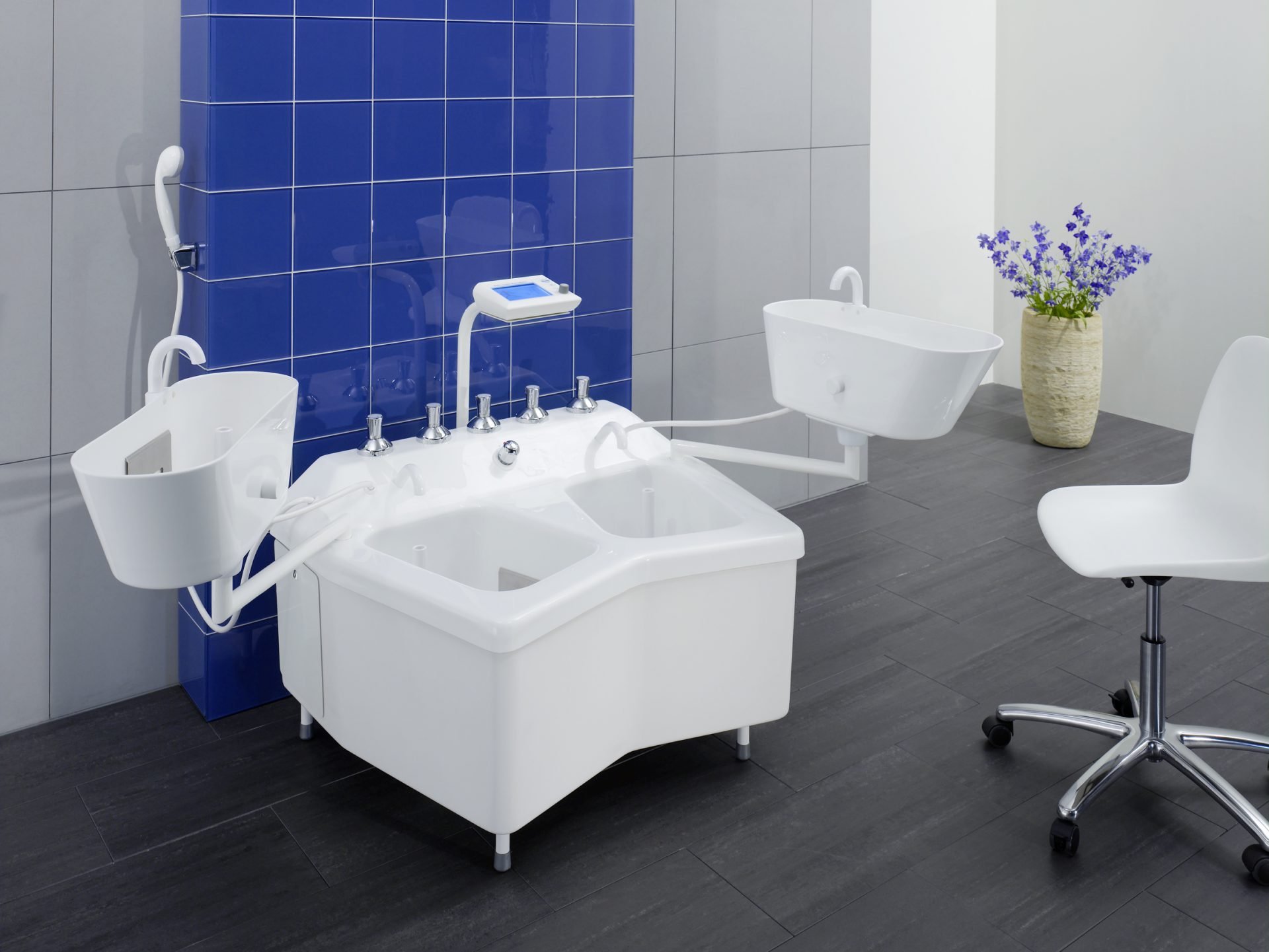
Take a look at our range of wellness baths
Safety and water hygiene in hydrotherapy
Because of its unique characteristics, attention should be given in selecting the appropriate type of hydrotherapy equipment. Most hospitals and rehabilitation institutions have little experience working with water or pools. Because the pools are used by those who are prone to infection, additional attention must be paid to water hygiene. A hydrotherapy pool requires a water treatment facility to provide at least the these basic functions unless the water is replenished after each session:
- disinfection with a disinfecting agent such as chlorine or bromide
- filtration, to take solid contaminants out of the water
- circulation
- heating, to maintain a proper temperature for hydrotherapy
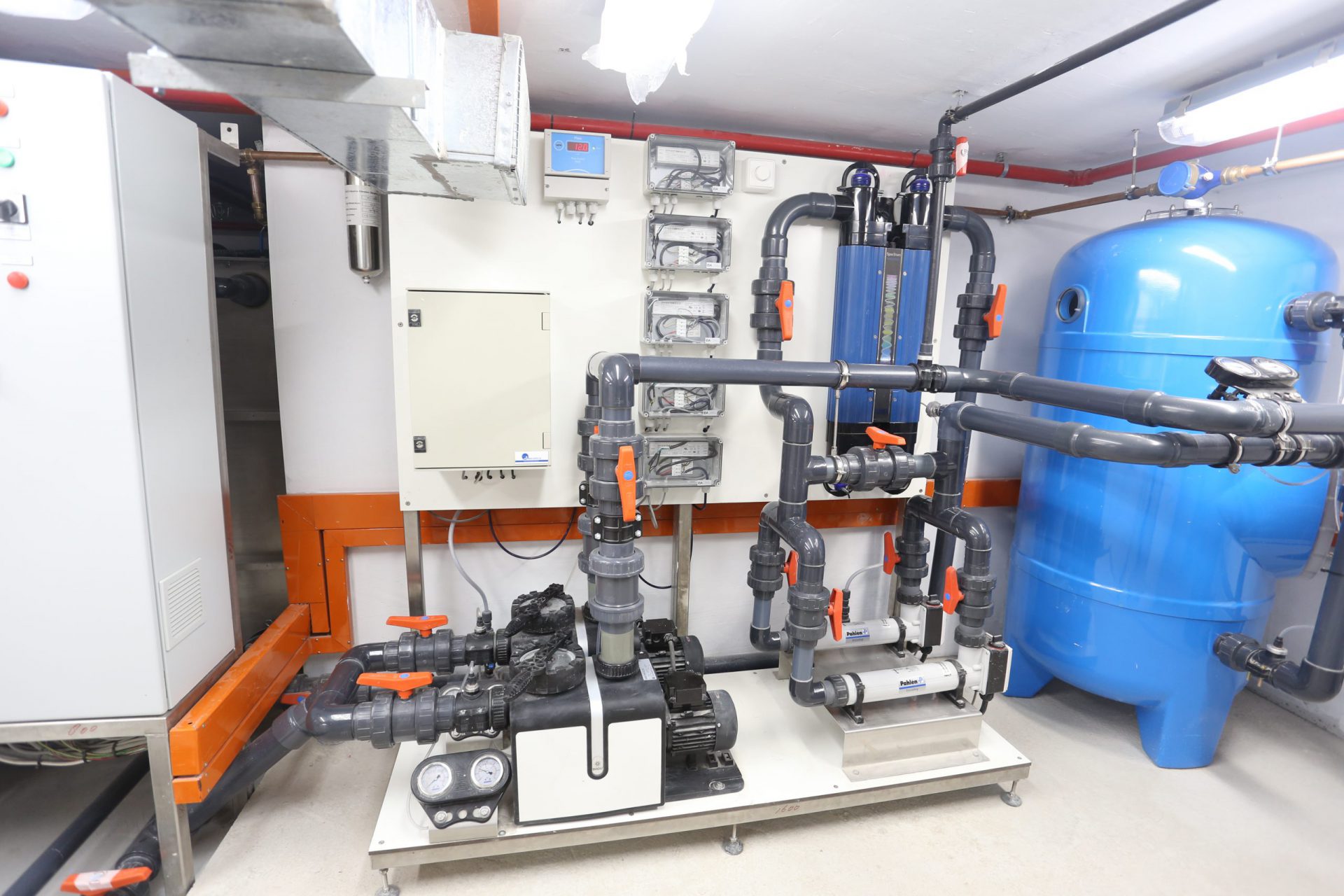
Take a look at our water treatment systems
Improving pool accessibility with hoisting equipment
When building a hydrotherapy area, consider the patient flow through the changing area with showers and toilets, to the pool, and back to the changing area. For patients to enter and depart the pool easily, the pool area requires particular infrastructure such as hoisting equipment and stairs. The transfer accessories can be used in place of, or in addition to, a movable swimming pool floor.
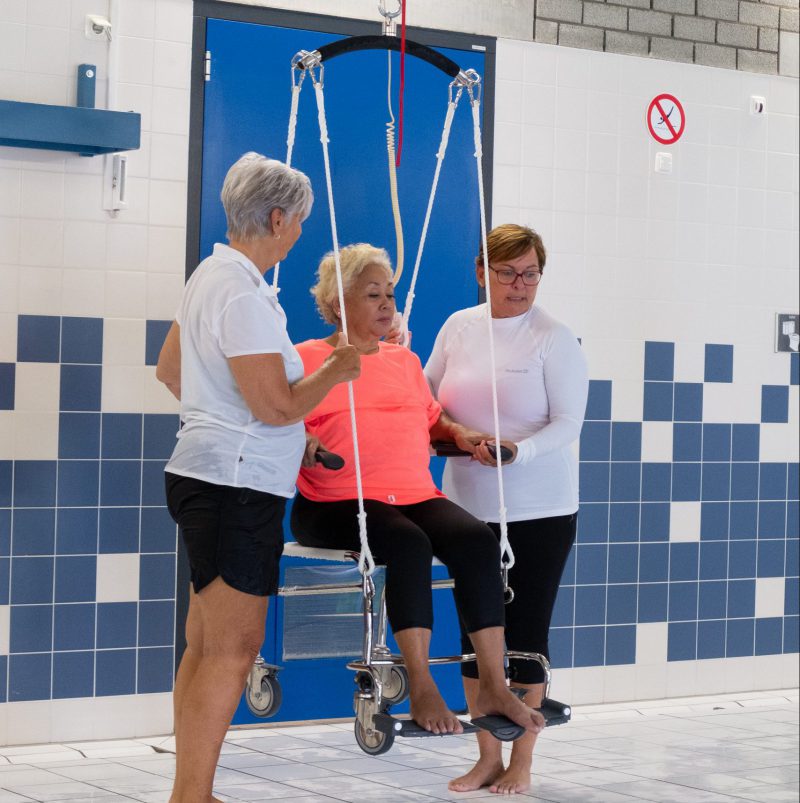
Hoisting chair suspended from overhead lifterTake a look at our transfer accessories
Increase the possibilities, add a movable floor to your swimming pool
However, when building a hydrotherapy space, one must consider the variety of people who will utilize the hydrotherapy equipment. Active and passive hydrotherapy require different sets of equipment, and it is especially crucial to consider the option of a movable floor in active hydrotherapy to expand the range of possible exercises and individuals that can be treated in the pool.
To learn more about the design and planning of Aquatic Therapy facilities, read: Planning and Design of hydrotherapy pool equipment, Practical Considerations for Aquatic Therapy.
Based on the needs of the customer, EWAC Medical can take an active role in developing the hydrotherapy area in any application.
